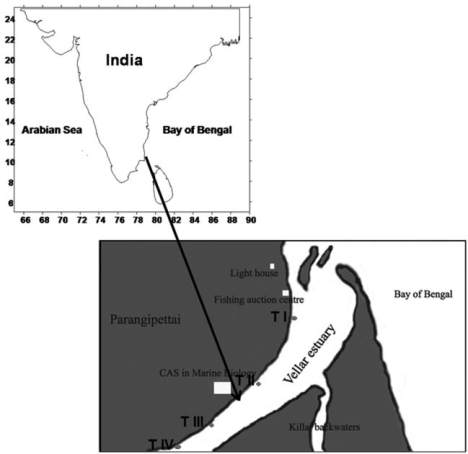Basic HTML Version


International Journal of Marine Science 2014, Vol.4, No.47, 1-11
http://ijms.biopublisher.ca
2
nutrient rich sediment layer along the estuarine edges
(Kathiresan et al., 1996; Ansari et al., 2014). An
artificial mangrove plantation covering an area of 10
ha was established in 1991 on the northern bank of the
estuary (Kathiresan et al., 1996; Ajmal Khan et al.,
2005).
Few studies have been carried out on benthic
organisms from this estuary (Ajmal Khan et al., 1975;
Chandran et al., 1982; Fernando et al., 1984;
Chandran, 1987; Fernando, 1987). After the artificial
mangrove plantation, Murugasan et al. (2007) have
studied the temporal changes in the benthic
community structure in marine zones of the estuary,
Ranjitham et al. (2008) have investigated seaweed and
seagrass associated fauna, and recently Ansari et al.
(2014) have studied the interaction between marine
nematodes and mangrove plants. Other than that, there
is no much more information regarding the intertidal
macrobenthic distribution and diversity of Vellar
estuary after mangrove plantation. In this backdrop,
the present study objective was designed to detect the
seasonal changes of the intertidal macrobenthic
community assemblages with relation to abiotic
variables in this region and to compare the variabilities in
abundance and species composition of macrobenthic
community before and after the mangrove vegetation.
1 Materials and Methods
1.1 Study site
The study was undertaken in the Vellar estuary (Figure
1) in the southeast coast of India (Latitude 11°29' N;
Longitude 79°46' E). Intertidal sediment samples were
collected for one year and formulated to seasonally
(July, August and September - premonsoon-2007;
October, November and December - monsoon-2007;
January, February and March - postmonsoon- 2008
and April, May and June - summer 2008) along four
selected transects within the estuary. Transect I was
located in marine zone (estuarine mouth) with high
amount of sea water entering through tidal action,
transects II and III were located in tidal zone (artificial
mangroves environment and oyster bed, respectively)
with higher nutrient rich environment because of
degradation, and transect IV was partially located in
freshwater zone with high terrestrial input including
organic load from Parangipettai town. The position of
the river mouth changes frequently due to sand bar
formation. The disappearance of the bar depends upon
the amounts of freshwater flow from upstream during
the monsoon months (normally this region experiences
an annual rainfall between 1200 and 1300 mm).
Figure 1 Map of Vellar estuary showing sampling stations (T1 –
marine zone; T2 – tidal zone (artificial mangroves); T3 – tidal
zone (oyster bed) and T4 – partially freshwater zone)
1.2 Sample processing
Physico-chemical variables from sediment overlying
water were measured by standard methods. Temperature
was measured with thermometer with ± 0.5
℃
accuracy, salinity with refractometer (manufacturer
and model?), pH with pH meter (Elico Ltd), and
dissolved oxygen concentrations were measured using
Winkler’s method following Strickland and Parsons
(1972). Textural analysis of the surface sediments was
made by the pipette method (Krumbein and Pettijohn,
1938). The total organic carbon content was measured
by the chromic acid oxidation method followed by
titration with ammonium ferrous sulfate (Walkley
Black method) modified by Gaudette et al. (1974).
Sediment samples of 1 m
2
were collected for faunal
observation during low tide using a quadrate method
(Alongi, 1990). In the order to ensure precision, three
duplicate samples were collected at each transect. The
sediment samples were sieved through a set of sieves
(1 mm and 0.5 mm). The organisms retained on the
sieve were preserved by 4% neutral formalin and
stained with Rose Bengal (0.1 g in 100 ml of distilled
water) to facilitate further sorting and identification in
the laboratory using the standard taxonomic keys (e.g.
Polychaeta: Fauvel (1953), Day (1967); Mollusca:

